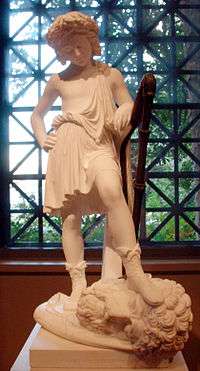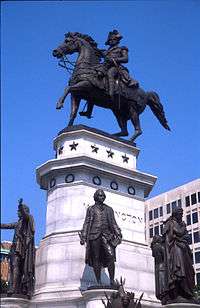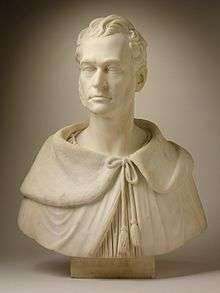Thomas Crawford (sculptor)
Thomas Gibson Crawford (March 22, 1814 – October 10, 1857) was an American sculptor who is best known for his numerous artistic contributions to the United States Capitol, including the Statue of Freedom atop its dome.
Thomas Crawford | |
|---|---|
.jpg) Thomas Crawford, 1846 | |
| Born | Thomas Gibson Crawford March 22, 1814 |
| Died | October 10, 1857 (aged 43) London, United Kingdom |
| Occupation | Sculptor |
| Spouse(s) | Louisa Cutler Ward
( m. 1844; |
| Children | 4, including Francis and Mary |
| Parent(s) | Aaron Crawford Mary Gibson |
Early life
Crawford was born in New York City in 1814, of Irish parentage, the son of Aaron and Mary (née Gibson) Crawford.[1] In his early years, he was at school with Page, the artist. His proficiency in his studies was hindered by the exuberance of his fancy, which took form in drawings and carvings. His love of art led him, at the age of 19, to enter the New York City studios of John Frazee and Robert Eberhard Launitz, artists and artificers in marble.[2]
In 1834, he went abroad for the promotion of artistic studies, and in the summer of 1835 took up his residence in Rome, for life as it proved. Launitz had provided Crawford with a letter of introduction to Bertel Thorwaldsen and upon arriving in Rome, Crawford became a pupil of Thorwaldsen.[3] Under his guidance, Crawford devoted himself to the study both of the antique and of living models.[4]
Career


His first ideal work was a group of Orpheus and Cerberus, executed in 1839, and purchased, some years later, for the Boston Athenaeum, and now displayed at the Museum of Fine Arts, Boston. This was followed by a succession of groups, single figures, and bas-reliefs, whose rapid production bore witness to the fertility as well as the versatility of his genius. Among these are Adam and Eve and a bust of Josiah Quincy, in 1900 in the Boston Athenaeum; Hebe and Ganymede, presented to the Boston Museum of Fine Arts by C. C. Perkins, and a bronze statue of Beethoven, presented by the same gentleman to the Boston Music Hall, which now resides at the New England Conservatory; Babes in the Wood, in the Lenox Library; Mercury and Psyche; Flora, now in the gallery of the late Mrs. A. T. Stewart; an Indian girl; Dancing Jenny, modelled from his own daughter; and a statue of James Otis, which once adorned the chapel at Mount Auburn Cemetery, Cambridge. In 1838, he was elected into the National Academy of Design as an Honorary Academician.

In 1849, while on a visit to this country, he received from the state of Virginia an order for a monument to be erected in Richmond. He immediately returned to Rome and began the work, of which the design was a star of five rays, each one of these bearing a statue of some historic Virginian, Patrick Henry and Thomas Jefferson among the number. The work is surmounted by a plinth, on which stands an equestrian statue of George Washington. These statues, modeled in Rome, were cast at a Munich foundry.[4]
U.S. Capitol
Crawford's most important works after these were ordered by the federal government for the United States Capitol at Washington. First among these was a marble pediment bearing life-size figures symbolical of the progress of American civilization; next in order came a bronze figure Freedom Triumphant in War and Peace which surmounts the dome; and last of these, and of his life-work, was a bronze door on which are modelled various scenes in the public life of Washington. Prominent among Crawford's works was also his statue of an Indian chief, much admired by the English sculptor Gibson, who proposed that a bronze copy of it should be retained in Rome as a lasting monument.[4]
His major accomplishments include the figure above the dome of the United States Capitol entitled Freedom Triumphant in War and Peace, the Revolutionary War Door in the House wing, and the bronze doors and pediment statues for the Senate wing. He was only able to begin the bas-reliefs for the bronze doors, which were afterwards completed by W. H. Rinehart.
Personal life
In 1844, he married Louisa Cutler Ward, a daughter of Julia (née Cutler) Ward and banker Samuel Ward. Among her siblings was brother Samuel Cutler Ward, who married Emily Astor (daughter of William Backhouse Astor Sr.) and sister Julia Ward, who married Samuel Gridley Howe.[5] Together, Thomas and Louisa were the parents of four children, including:
- Mary Crawford Fraser (1851–1922),[6] a writer who in 1874 married diplomat Hugh Fraser (1837–1894), who served as the United Kingdoms Ambassador to Japan from 1889 to 1894 during the reign of Queen Victoria and Emperor Meiji.[7]
- Francis Marion Crawford (1854–1909), a writer who married Elizabeth Berdan, the daughter of the Union General Hiram Berdan, in 1884.
In politics he was a liberal, in religion a Protestant, in character generous and kindly, and adverse to discords, professional or social.[4]
Crawford began experiencing significant deterioration in his vision in 1856, which ended his career. He sought medical treatment in Paris, Rome, and London, and physicians discovered cancer of the eye and cancer of the brain. He died in London on October 10, 1857. His body was returned to the United States, and he was buried in an unmarked grave at Green-Wood Cemetery in Brooklyn, New York.[8]
Works
- Mexican Girl Dying (1848)
- Statue of Freedom (1862)
- Revolutionary War Door (1905)
References
- Notes
- Gale 1964, p. 5.
- Tolles, Thayer (2000). "Modeling a Reputation: The American Sculptor and New York City". In Voorsanger, Catherine Hoover; Howat, John K. (eds.). Art and the Empire City, New York, 1825-1861. pp. 147–148. ISBN 0-87099-957-5.
- "Thomas B. Crawford, American (1813 - 1857)". Ro Gallery.
- Appletons' 1900.
- "Samuel Ward Papers" (PDF). nypl.org. New York Public Library Archives. Retrieved 7 February 2017.
- Jozef Rogala (2001). A Collector's Guide to Books on Japan in English. Routledge. pp. xiii. ISBN 1-873410-90-5.
- "FRASER, Mrs. Hugh". Who's Who. Vol. 59. 1907. p. 636.
- Gale 2003, p. 51.
- Sources

- Gale, Robert L. (1964). Thomas Crawford: American Sculptor. Pittsburgh: University of Pittsburgh Press. ISBN 031332350X.CS1 maint: ref=harv (link)
- Gale, Robert L. (2003). A Henry Wadsworth Longfellow Companion. Westport, Conn.: Greenwood Press. ISBN 031332350X.CS1 maint: ref=harv (link)
- This article incorporates text from a publication now in the public domain: Howe, Julia Ward (1900). . In Wilson, J. G.; Fiske, J. (eds.). Appletons' Cyclopædia of American Biography. New York: D. Appleton.
External links
| Wikimedia Commons has media related to Thomas Crawford (sculptor). |
- , Marking an Artist’s Forgotten Grave with His Own Sculpture of Death
- Art and the empire city: New York, 1825-1861, an exhibition catalog from The Metropolitan Museum of Art (fully available online as PDF), which contains material on Crawford (see index)
- Bust of Thomas Crawford at the New-York Historical Society by Giuseppe Blasetti.